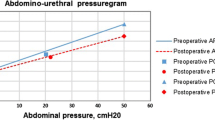Abstract
The aim of the study was to evaluate the use of a vaginal pessary in the detection of genuine stress incontinence (GSI) in women with urogenital prolapse undergoing urodynamic investigation. Continent women with urogenital prolapse, with or without associated urinary symptoms, were studied. All underwent video-cystourethrography using a standarized protocol. None had evidence of incontinence on provocative testing in the upright position. A well-fitting vaginal ring pessary was inserted to reduce the prolapse and mimic a vaginal repair. The provocative tests were then repeated while the bladder was screened. Seventy women with a mean age 59.0 years (range 34–83) were recruited over a 21-month period: 15 women complained of prolapse alone and 55 had concurrent urinary symptoms; 19 women (27%) developed GSI only following the insertion of a vaginal pessary. The women who became incontinent were significantly older (mean age 63.9 years) than those who remained continent (mean age 56.8 years) (P<0.020). The use of a vaginal pessary increases the detection rate of GSI in continent women with urogenital prolapse undergoing videocystourethrography. These findings are important becasuse women with prolapse and coexisting incontinence should be offered a continence procedure rather than a simple vaginal repair.
Similar content being viewed by others
References
Stanton SL, Hilton P, Norton C, Cardozo L. Clinical and urodynamic effects of anterior colporrhaphy and vaginal hysterectomy for prolapse with and without incontinence.Br J Obstet Gynaecol 1982;89:459–463
Borstad E, Rud T. The risk of developing urinary stress-incontinence after vaginal repair in continent women.Acta Obstet Gynecol Scand 1989;68:545–549
Bump RC, Fantl JA, Hurt WG. The mechanism of urinary continence in women with severe urogenital prolapse: results of barrier studies.Obstet Gynecol 1988;72:291–295
Richardson DA, Bent AE, Ostergard DR. The effect of uterovaginal prolapse on urethrovesical pressure dynamics.Am J Obstet Gynecol 1983;146:901–905
Stanton SL. Vaginal prolapse. In: Shaw R, Soutter P, Stanton S, eds. Gynaecology. Edinburgh: Churchill Livingstone, 1992;437–447
Rosenzweig BA, Pushkin S, Blumenfield D, Bhatia NN. Prevalence of abnormal urodynamic test results in continent women with severe genitourinary prolapse.Obstet Gynecol 1992;79:539–542
Hertogs K, Stanton SL. Mechanism of urinary continence for colposuspension: barrier studies.Br J Obstet Gynaecol 1985;92:1184–1188
Bhatia NN, Bergman A, Gunning JE. Urodynamic effects of a vaginal pessary in women with stress urinary incontinence.Am J Obstet Gynecol 1983;147:876–884
Bhatia NN, Bergman A. Pessary test in women with urinary incontinence.Obstet Gynecol 1995;65:220–226
Bergman A, Koonings PP, Ballard CA. Predicting postoperative urinary incontinence development in women undergoing operation for genitourinary prolapse.Am J Obstet Gynecol 1988;158:1171–1175
Author information
Authors and Affiliations
Additional information
Editorial Comment: All patients with significant uterovaginal prolapse require preoperative evaluation to rule out the presence of potential stress incontinence. The simplest and best way to perform this preoperatively has yet to be determined, although several methods have been described. These include a cough stress test or cough urethral profile performed with a full bladder with the prolapse reduced with a Sims' speculum, a pessary or vaginal packing. A pad test with the prolapse reduced in a similar fashion has also been used clinically to identify patients at risk for postoperactive potential stress incontinence following correction of pelvic prolapse. The authors present their experience using a ring pessary to reduce the prolapse during videourodynamic evaluation of lower urinary tract function, finding this technique to be effective in identifying patients who leak only with the pessary in place, and therefore, require an incontinence procedure. The pickup rate for this cohort of patients is similar to previous studies using alternative methods of detection. Perhaps the only question yet to be answered is the percentage of patients with negative testing preoperatively, yet who develop urinary incontinence immediately following surgical correction of pelvic relaxation. Only this determination will truly assess the clinical utility of the preoperative methods used to identify potential stress incontinence.
Rights and permissions
About this article
Cite this article
Hextall, A., Boos, K., Cardozo, L. et al. Videocystourethrography with a ring pessary in situ. A clinically useful preoperative investigation for continent women with urogenital prolapse?. Int Urogynecol J 9, 205–209 (1998). https://doi.org/10.1007/BF01901605
Issue Date:
DOI: https://doi.org/10.1007/BF01901605




